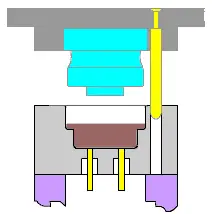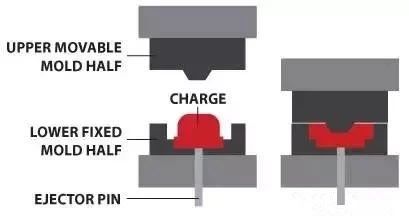Thermoplastic Compression Molding: Benefits, Process, and Applications
- Suase /
- SUASE NEWS
Thermoplastic compression molding is a great way to make complicated parts out of plastic. This technique is widely adopted across various industries, including automotive, electronics, consumer goods, and medical devices. In this guide, we will explore the fundamentals of thermoplastic compression molding, its key advantages, the step-by-step process, and its diverse range of applications.
What is Thermoplastic Compression Molding?
Thermoplastic compression molding involves putting a measured amount of thermoplastic material (usually in the form of pellets or powder) into a heated mold. The mold closes under pressure, and the thermoplastic material softens, flows, and fits into the mold. Once the material cools, it becomes solid, and the finished part is created. Unlike thermosetting compression molding, thermoplastic compression molding uses materials that can be reheated and reshaped multiple times, making it ideal for high-volume, cost-effective production.

Key Characteristics of Thermoplastic Materials
Thermoplastic materials are polymers that soften when heated and solidify when cooled, which makes them ideal for molding processes like compression molding. These materials are widely used because of their excellent physical properties, such as:
- Reusability: You can reheat and reuse thermoplastics, which makes them great for recycling and reducing material waste.
- Durability: These materials can resist high impacts, are chemically stable, and flexible, which makes the molded parts durable.
- Cost-Effectiveness: Thermoplastic polymers are relatively inexpensive compared to other materials, making them a cost-efficient choice for mass production.
Common thermoplastic materials used in compression molding include:
- Polypropylene (PP)
- Polyethylene (PE)
- Polycarbonate (PC)
- Acrylonitrile Butadiene Styrene (ABS)
- Polyamide (Nylon)
The benefits of thermoplastic compression molding
Thermoplastic compression molding has a lot of advantages, which is why it is used a lot in many industries. Here are some of the main advantages:
1. High Precision and Detail
The compression molding process is very precise. This means that it can make very complex shapes with very tight tolerances. This is very useful in industries that need detailed components, such as the car and medical industries.
2. Shorter Cycle Times
Thermoplastic materials can cool and solidify more quickly than thermosetting polymers. This means faster production cycles and higher output, which is particularly good for industries where time-to-market is important.
3. Design Flexibility
Thermoplastic compression molding allows for a wide range of part designs, including thin-walled structures, undercuts, and complex geometries. This flexibility means you can create innovative product designs without compromising functionality.
4. Cost-Effective Production
The thermoplastic molding process uses minimal material and is therefore low-cost. It uses relatively inexpensive raw materials and can be recycled, which supports sustainability.
5. Reduced Tooling Costs
The tooling used in thermoplastic compression molding is simpler and less expensive than in other molding processes, such as injection molding or blow molding. This means that the costs are lower for manufacturers, especially when they are making a lot of products.
6. Superior Surface Finish
Thermoplastic compression molded parts often have a smooth and polished surface finish, which eliminates the need for additional post-processing steps like painting or coating.

The Thermoplastic Compression Molding Process
The process of thermoplastic compression molding is straightforward, yet requires precise control over various parameters to ensure high-quality results. Here's a step-by-step breakdown of the procedure:
1. Material Preparation
The thermoplastic material is typically supplied as pellets, powder, or preforms. These are prepared by drying or pre-heating to the desired temperature to ensure optimal flow during molding.
2. Mold Design and Setup
A two-part mold is designed and set up, with each part of the mold being crafted to the specific part geometry. The mold is heated to the required temperature to facilitate the material flow and prevent premature solidification.
3. Material Loading
A predetermined amount of thermoplastic material is placed into the cavity of the open mold. The quantity is carefully measured to avoid overfilling or underfilling.
4. Molding Cycle
The mold is closed, and pressure is applied to force the thermoplastic material to flow and fill the entire cavity. The mold temperature and pressure are maintained for a specific period to allow the material to fully conform to the mold's shape.
5. Cooling and Ejection
After the material has fully formed into the desired shape, the mold is cooled to solidify the thermoplastic material. Once cooled, the mold is opened, and the finished part is ejected.
6. Post-Processing (if required)
Depending on the part design, there may be extra steps such as trimming, surface finishing, or assembly to finish the product.
Applications of Thermoplastic Compression Molding
Thermoplastic compression molding is used in many industries to make high-quality, durable, and lightweight parts. Some of the most common applications include:
1. Automotive Industry
In the automotive sector, thermoplastic compression molding is used to make bumpers, instrument panels, dashboard parts, and interior trim pieces. It is very important that this process can make very precise shapes, because car parts have to meet very strict standards.
2. Electronics and Electrical Components
Compression molding is perfect for making housings, connectors, switches, and insulators in the electronics industry. The electrical insulation properties of thermoplastics make them perfect for components used in circuit boards and other electronic devices.
3. Consumer Goods
The consumer goods industry uses thermoplastic compression molding to make items such as kitchenware, furniture components, and household appliances. The fact that thermoplastics can be used in so many different ways allows for a broad range of product designs.
4. Medical Devices
Medical applications like syringes, inhalers, diagnostic equipment, and surgical instruments often use a process called compression molding to make very precise parts.The materials used in this industry must meet very strict rules, and be both safe and work well.
5. Aerospace and Defense
Aerospace manufacturers often use thermoplastic compression molding to make lightweight, durable parts for the inside of aircraft, and for parts that are important to the structure of the aircraft. The process allows for the production of complex, high-performance parts that meet the strict requirements of the aerospace sector.
6. Packaging
compression molding is also widely used for creating packaging solutions such as bottle caps, containers, and caps for food and beverages, where high-volume production and durability are essential.
Challenges in Thermoplastic Compression Molding
Thermoplastic compression molding has many advantages, but there are also some challenges. Some of the issues include:
- Limited Material Compatibility: Not all thermoplastic materials are suitable for compression molding. It is crucial to select the right material based on the specific part requirements.
- Mold Design Complexity: Although the tooling costs are lower, the complexity of mold design can increase with intricate part geometries, requiring more advanced mold engineering.
- Warpage and Shrinkage: Parts made from thermoplastics may experience warpage or shrinkage during the cooling process. This can be mitigated through careful temperature control and material selection.
Conclusion
Thermoplastic compression molding is a powerful and efficient manufacturing process that delivers high-quality, cost-effective parts across a broad range of industries. Its ability to produce intricate shapes, combined with the fact that it can be used with a wide range of materials and the fact that it doesn't cost a lot to make the moulds, makes it an attractive option for many manufacturing applications. It is used in many industries, including the automotive, electronics, medical and consumer goods sectors. It can make very precise, strong and long-lasting parts. Manufacturers can use this process to make products more quickly and improve their quality.
